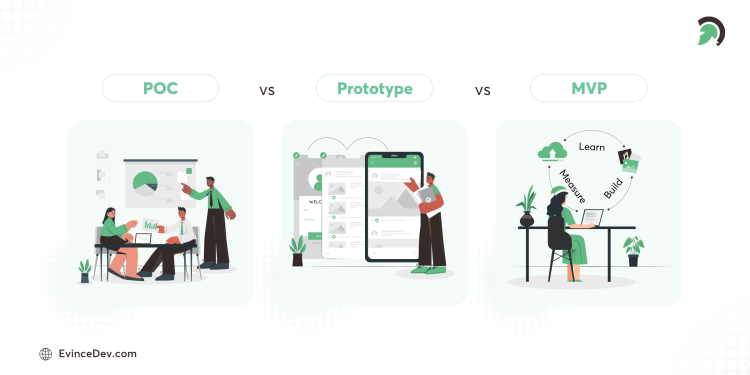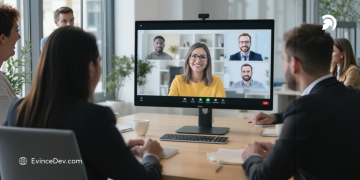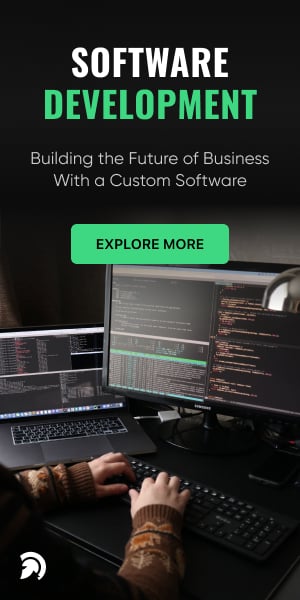One of the most crucial decisions when launching a startup revolves around choosing the right development approach. Whether Proof of Concept (PoC), Prototype, or Minimum Viable Product (MVP), understanding each stage of product development is vital for building a successful product that resonates with users.
In the world of MVP development, product development, and software development for startups, selecting the correct path significantly influences time-to-market, cost efficiency, and, ultimately, the success of your product. Whether you’re in the early planning phases or looking to scale, this blog will help you understand the differences between these stages and guide you in choosing the right approach for your startup. We’ll explore each stage in-depth, highlighting their benefits, key features, and practical use cases in custom product design and development.
Only 1% of startups become unicorn firms like Uber, Airbnb, Slack, Stripe, and Docker.
What are POC, Prototype, and MVP?
Proof of Concept (POC)
A Proof of Concept (PoC) is a small-scale demonstration to verify an idea’s feasibility. It’s a low-cost way of testing whether a concept is technically possible or not. At this stage, the focus is not on functionality or user experience; it’s all about proving the underlying idea works in theory.
Key Features of PoC
- Proves technical feasibility or viability.
- It focuses primarily on testing whether an idea is possible.
- Minimal investment, as it’s usually not a full product but rather proof to justify further development.
When Should You Use PoC?
- You’re working with a new technology (e.g., AI, blockchain, or IoT) and want to test its feasibility.
- You want to convince investors or stakeholders of the potential of your idea.
- Your concept is complex or disruptive, and you must ensure it’s technically viable before moving forward.
POC Best Practices
Incorporating best practices ensures a PoC achieves its objectives efficiently and sets a solid foundation for further development.
Key Practices:
- Define Clear Objectives: Outline the specific technical challenges or hypotheses to test.
- Limit Scope: Focus on a single core idea to avoid resource wastage.
- Engage Stakeholders Early: Align expectations by involving technical and business teams during the PoC phase.
- Document Outcomes: Keep a detailed record of successes, challenges, and learnings for future reference.
Prototype
A Prototype is a preliminary model of your product designed to showcase its functionality and user interface (UI). Unlike a PoC, a prototype is closer to the final product, though it may not be fully functional. It’s more about refining the design and getting user feedback.
Key Features of a Prototype
- Demonstrates how the product will work and look.
- Focuses on user experience (UX) and design.
- Not fully functional; used primarily to test concepts visually.
Major Prototype Models
Prototyping methods vary based on the goals and scope of the product, helping developers choose the right approach.
Common Models:
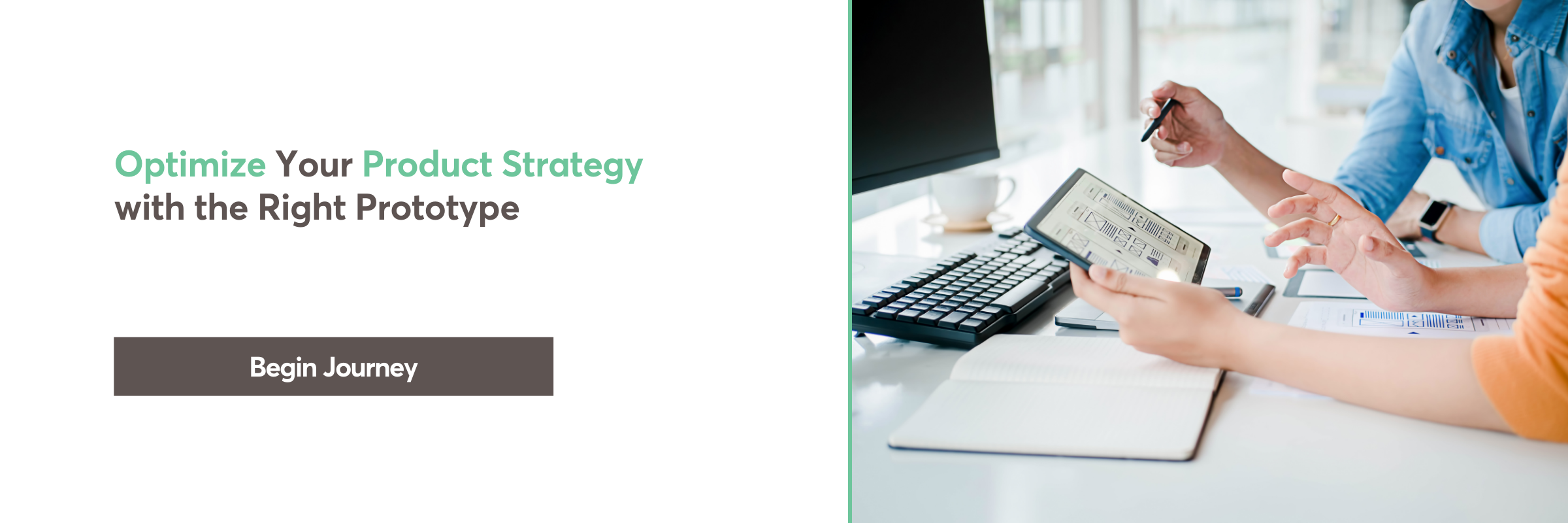
- Low-Fidelity Prototypes: Basic sketches or wireframes to outline core ideas quickly.
- High-Fidelity Prototypes: Interactive, detailed representations close to the final product for advanced usability testing.
- Throwaway Prototypes: Created for a single-use purpose, often discarded post-testing.
- Evolutionary Prototypes: Continuously improved models that evolve into the final product.
When Should You Use a Prototype?
- You want to showcase the product to stakeholders, investors, or early adopters.
- Gathering early user feedback on design and usability is essential.
- You must make design decisions and validate UI/UX before fully developing.
3. Minimum Viable Product (MVP)
A Minimum Viable Product (MVP) is the first version of your product that is usable by real users. It includes only the most essential features required to solve the primary user problem. Unlike PoC or Prototype, the MVP is fully functional and can be used by customers for real-world validation.
Key Features of an MVP
- It contains only core functionalities that address the primary user problem.
- Fully functional and ready for market testing.
- It helps startups collect user feedback to iterate and improve the product.
When Should You Use an MVP?
- You’re ready to launch your product and test real-world demand.
- You want to attract early adopters and gain insights for future development.
- You want to focus on core features and avoid the risk of developing unnecessary functionalities early on.
POC vs Prototype vs MVP: Understanding the Key Differences
To choose between PoC, Prototype, and MVP easier, let’s break down the key differences:
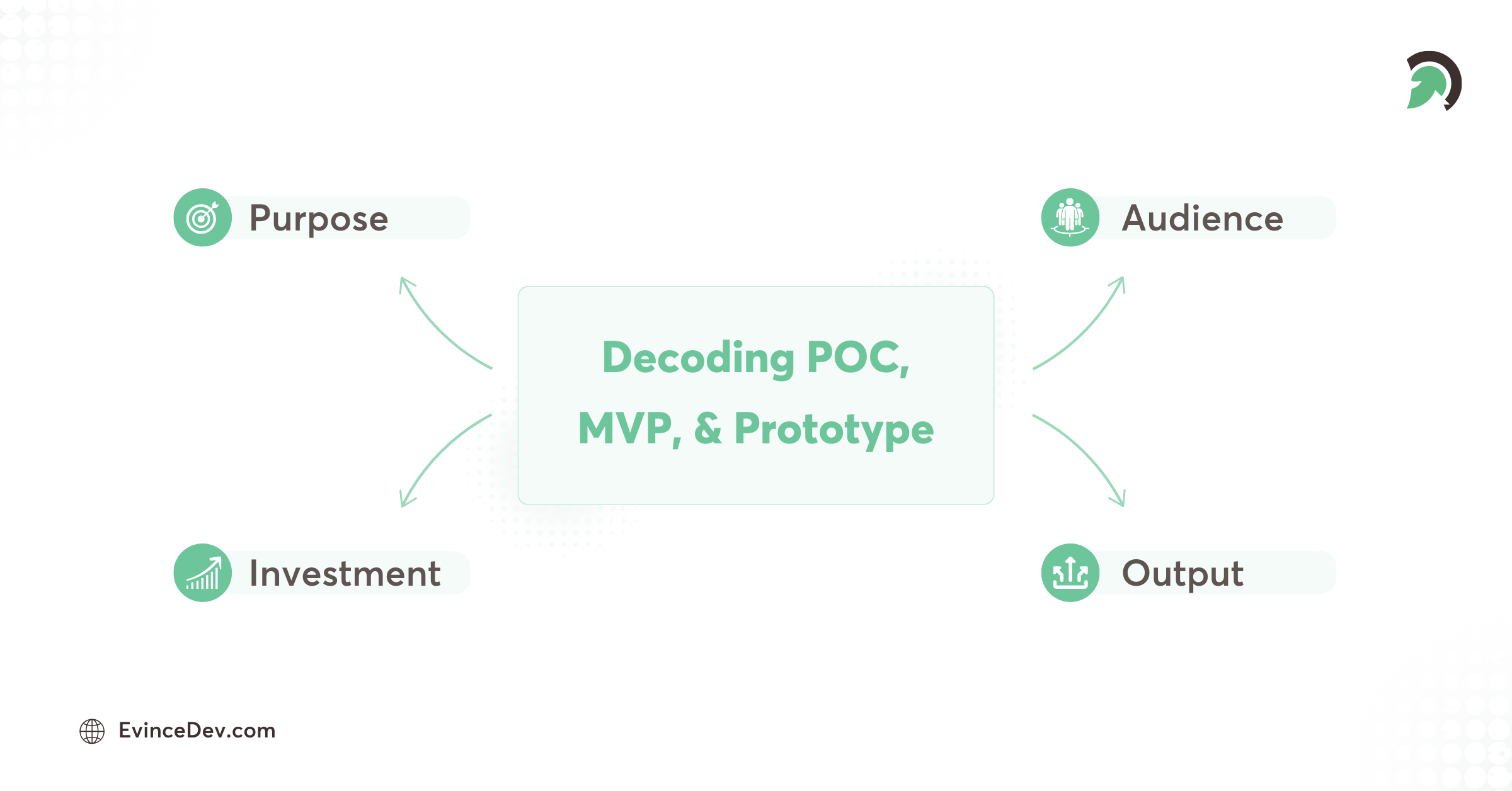
Purpose
- PoC: The main goal is to test whether the idea is technically feasible.
- Prototype: It’s about testing how users interact with the design and ensuring the concept makes sense.
- MVP: Aimed at market validation — does the product fulfill real user needs, and is there demand?
Investment
- PoC: Typically low cost, as the goal is to test an idea rather than build a product.
- Prototype: Moderate investment, as it involves more design and development to test usability and concept.
- MVP: It requires the most investment as it’s a fully functional product that is market-ready.
Audience
- PoC: Primarily for internal use, stakeholders, and technical teams to validate feasibility.
- Prototype: Investors, designers, potential users, and early adopters to get feedback on design and usability.
- MVP: Real customers and end-users to gauge market acceptance and usability.
Output
- PoC: It can be as simple as a demo, a document, or a model that proves technical feasibility.
- Prototype: A working model, either interactive or a static mockup, that represents the final product’s look and feel.
- MVP: A fully functional product, even if it’s limited in features, designed to be tested in the market.
How PoC, Prototype, and MVP Fit Into the Product Development Cycle
Startups often follow a step-by-step approach when developing their products, and each of these stages plays a unique role:
PoC in Product Development
Initially, a PoC helps validate whether your concept is worth pursuing. If the PoC fails, it saves your startup from wasting resources on a potentially unfeasible idea. It’s like a “proof of the concept” before significant design or development efforts begin. The focus at this stage is custom software development with minimal resources.
Prototype and Early-Stage Design
Once you have a feasible idea, the next step is to create a Prototype. This stage is essential for understanding the product’s design, user experience, and flow. It helps refine the idea before investing time and money into full-scale software development stages. Design decisions are tested and refined based on user feedback during this phase.
MVP for Market Validation
Once you have your PoC and prototype validated, the next step is to launch your MVP. This product will contain only the most essential features required to solve the user’s problem. The MVP is your first opportunity to test the product with real users in the market, gather valuable feedback, and iterate on the product.

Why Startups Should Choose Carefully
Choosing between PoC, Prototype, and MVP can be daunting for startups. Here’s when each is beneficial:
When to Choose PoC
- When the idea involves untested or disruptive technology (e.g., AI, blockchain, IoT).
- You want to check the feasibility of the concept before committing resources.
- Your goal is to secure funding or buy-in from investors or stakeholders.
When to Choose Prototype
- You must validate your product’s user interface (UI) and user experience (UX).
- You want to demonstrate the concept to potential investors or early users.
- Feedback on design is critical before proceeding to full development.
When to Choose MVP
- You’re ready to take your product to market and validate its business potential.
- You want to gain early adopters and start building a customer base.
- You aim to test the core functionalities of your product in real-world conditions.
Which Stage Should You Choose?
Each stage — PoC, Prototype, and MVP — has its place in the startup development process. While PoC is crucial for validating your concept, the prototype focuses on refining design, and the MVP is key for market validation.
For startups looking to maximize their chances of success in today’s competitive landscape, MVP app development is often the logical next step after testing the idea’s feasibility and refining the design. However, depending on your product and market needs, you may need to incorporate all three stages.
When you’re ready to move forward with your MVP or custom software development, we recommend considering EvinceDev. They specialize in mobile app development, custom software development, and MVP development tailored to your startup’s unique needs. Their team is experienced in guiding startups through every stage of the product development process, ensuring a smooth and successful launch.
